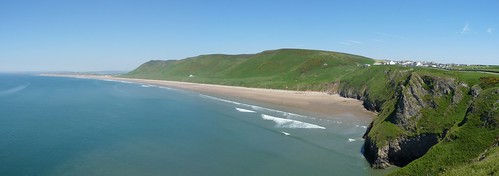Following our trip into mid Wales, Sunday was spent much closer to home on Gower though in no less spectacular surroundings. For the first time in a few months we visited Rhossili and Worms Head. The number of people there when we arrived was amazing with both overspill fields full and wardens directing traffic around. I guess it must be true that people are staying in the UK this year due to the recession. Fortunately the surrounding countryside absorbed the masses well so it never felt too busy.
Walking out along the headland our attention was drawn to a recently fledged family of Song Thrushes sitting inside a gorse bush. They posed very obligingly for photographs, showing off their quickly receding yellow gape in the process. Other inhabitants of the gorse included several Linnets as well as a Kestrel who kept landing on the ground in full view of the masses. There were also good numbers of Skylarks filling the sky with their tuneful calls.
The sea was an absolute mill pond, offering the perfect opportunity to see Shags and Cormorants fishing. The clear visibility also meant that a few distant Gannets could be picked out. Also making good use of the nice weather were several Fulmars which were making regular patrols of the cliffs.
As the tide fell away we were able to walk across the tidal causeway and over to Worms Head itself. The rock pools in-between were teeming with life. The shrimp were out in force, as were a couple of Hermit Crabs no doubt trying to escape what must have been a rapidly heating small pool. Strangely for this area we didn’t see a single Oystercatcher. Over the winter months there is usually a large colony here, so hopefully they have just moved on elsewhere to feed. I am slightly concerned however as there have been a few issues with the muscle beds in the area so I hope that this is not as a result of those problems.
Once on Worms Head both Rock and Meadow Pipits had young either being fed in nests or rather noisily out in the open. The highlight though were the vast numbers of Guillemot, and to a lesser extent Razorbill, that were roosting and feeding around the large vertical cliff on the north face of the furthest promontory. We spent a happy half an hour or so watching the birds coming and going but couldn’t work out if there were any young present. My biggest annoyance of the day was the attitude exhibited by many of the boat owners in the area. On more than one occasion we observed numerous boats driven deliberately and at speed directly into a raft of birds on the water. I am sorry but this is completely unacceptable. I’d like to think that even if a person were not that interested in the birds they would not intentionally try to harm them when a small adjustment of the steering wheel could avoid them completely. Clearly this isn’t the case and is just another sign of the problem we face in society today with its overly selfish attitude.
On a happier note a colony of Kittiwakes on the same cliffs do appear to have some young with them. Whether these have bred at the site or have moved around from the colony that occupies the pier at Mumbles I can’t be sure. If you haven’t visited this area I highly recommend it as the views are some of the best in Gower and the wildlife is more than capable of matching them. Do be careful when crossing to Worms Head however as people have been killed in the past when caught by the incoming tide. Safe crossing times are clearly displayed at both ends of the causeway so please do check them.




0 Comments